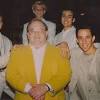Supermassive black hole in our galaxy captured in first ever picture

Scientists have taken the first ever image of the black hole at the heart of our galaxy, the Milky Way.
The picture is not only our first glimpse at the supermassive black hole – known as Sagittarius A* – but also the first direct evidence it actually exists.

Sagittarius A* is a thousand times smaller than M87*, but they are remarkably similar
(EHT Collaboration)
Scientists have long suspected that our galaxy is the home to such a huge, violent object: stars have been observed to be orbiting around something compact and massive at the centre of the Milky Way. While it appeared to be behaving like a black hole, it was invisible and impossible to confirm.
In the new image, the black hole itself stays invisible, because it is completely dark. But the picture shows the bright glowing ring that runs around it, and shows the way that light bends around the region.
Researchers describe the black hole as being “the glue that holds the galaxy together”.
“It is key to our understanding of how the Milky Way formed and will evolve in the future,” said Ziri Younsi from University College London, a researcher at Event Horizon Telescope (EHT) which captured the image.
It comes after the first image of any black hole, which was released in 2019 and depicted M87*, a much bigger example some 55 million light years away and was also captured by the EHT.
Creating the latest image has taken five years of work by more than 300 researchers from across the world. Even though Sagittarius A* is a mere 27,000 light years away, it was nonetheless the equivalent of taking a photograph of a doughnut on the Moon.
Now with two examples of black holes, scientists can study the differences, comparing and contrasting the two examples.
“Now we can study the differences between these two supermassive black holes to gain valuable new clues about how this important process works,” said EHT scientist Keiichi Asada, from the Institute of Astronomy and Astrophysics, Academia Sinica, Taipei.
“We have images for two black holes – one at the large end and one at the small end of supermassive black holes in the universe – so we can go a lot further in testing how gravity behaves in these extreme environments than ever before.”
The two black holes are remarkably similar. While M87* is one of the biggest black holes in the universe – about 1,000 times bigger than ours – and sits in the middle of a very different galaxy, they have very similar structures.
It proves Einstein was right and helps us understand what is actually happening in the structure of black holes, the researchers say.
“We have two completely different types of galaxies and two very different black-hole masses, but close to the edge of these black holes they look amazingly similar,” said Sera Markoff, co-chair of the EHT Science Council. “This tells us that general relativity governs these objects up close, and any differences we see further away must be due to differences in the material that surrounds the black holes.”
At some point, Einstein must be wrong, and scientists hope that future images can tell us more about the event horizon, or the very edge of the black hole, where Einstein’s theory would break down. With more detailed images, scientists hope that they can potentially see the point where that happens.
“The event horizon is the literal edge of space and time – everything we know about space and time breaks down at the event horizon. They don't have any meaning they cease to have any meaning cross it, and you’ll never return, you are causally disconnected, it’s a literal edge of the universe, of reality,” said Dr Younsi. “And we’re starting to see matter now very close to the edge – I think it’s amazing that human beings can even have the capacity to visualise that.”
Researchers now hope to gather more detail on our own black hole as well as take pictures of more of them, allowing for more detailed comparison and understanding of the still mostly mysterious objects. Better images would allow for more granularity, more wavelengths and also the ability to see what happens to the black hole over time, which would in turn allow scientists to measure the speed and velocity of what is happening around it.
The results are described in a series of papers published in a special edition of the journal, The Astrophysical Journal Letters.


 United Kingdom
United Kingdom Argentina
Argentina  Australia
Australia  Austria
Austria  Brazil
Brazil  Canada
Canada  Germany
Germany  Ireland
Ireland  Italy
Italy  Malaysia
Malaysia  Mexico
Mexico  New Zealand
New Zealand  Poland
Poland  South Africa
South Africa  United States
United States 
























